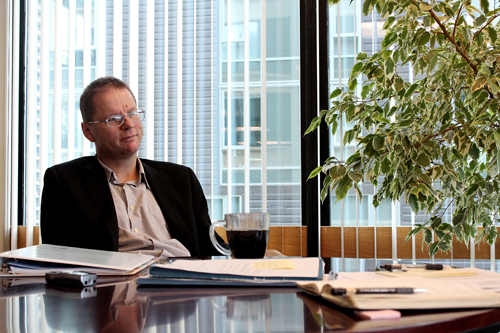On Jan. 19, Portland State unveiled the new university-wide budget model that will affect the 2012–13 academic year and will be fully implemented in the 2013–14 academic year. According to a press release issued by PSU, the change will “help the campus meet its academic and financial goals despite declining state funding.”

The proposed shift will result in a shadow budget model for the 2012–13 academic year and will function as a test model that will measure how the changes are implemented.
PSU currently operates using an incremental budget. Every year, the proposed budgets look identical and changes only occur when income is either generated or lost.
The new budget model has been part of an ongoing discussion within the university. Last year, a report released by the Financial Futures Task Force suggested that the university begin to pursue a new budget model that would better fit the needs of the university. It stated that, “As the state has disinvested in higher education, PSU has had to evolve to become a largely tuition and fees supported institution.”
“Consequently, the old methods of managing the university budget—which neither recognizes the gigantic shift in revenue sources nor incentives units to increase revenues as is required by a much more market driven institution—have proven inadequate,” the report concluded.
The new budget model is considered a performance-based budget, which means the school will allot funds to different departments and programs based on the larger benefit of the program. Under the new budget, the university would link the money allotted to programs to goals that the program would be expected to accomplish.
Monica Rimai, vice president for Finance and Administration, explained how the university will reward those who meet their goals: “The university will set performance standards for all participating units. A unit that meets those standards will be told ‘great, keep going.’”
Programs that exceed the expectations set by the new model will also see added benefit.
“A unit that exceeds those standards,” Rimai said, “one that is either is better at cost cutting inefficiencies or generating more revenue than expected, the idea here is that they will get to keep some portion of that additional increment of good conduct they receive.”
“The idea is that you’re incentivizing good performance,” Rimai said.
Other behaviors that would be incentivized would be student success, revenue generation and cutting cost inefficiency. Other factors considered for incentives are the ability for a program to conduct research and accrue funds through philanthropy.
Roy Koch, provost and vice president for Academic Affairs said, “The idea is to make a much clearer connection between the things we do and the money that those things generate.”
“The biggest advantage is that the model allows us to track where students’ tuition is going and how we are allocating it,” said Kevin Reynolds, vice provost for Fiscal Strategies and Planning. Reynolds also serves on the steering committee, along with Rimai, that was formed to research and implement the new plan. Additionally, a working group for the model has also been formed.
The steering committee will be asked to share their findings throughout the process in order to make the transition and planning more transparent.
The new proposed model “allows us to look at the cost of our services,” Reynolds said.
In the press release, the university reported that a staff member showed concern over the model and asked if it would determine the priorities of the university.
“Activities will still be guided by our institutional priorities,” Koch said.
When asked if the model could affect the quality of an education by incentivizing efficiency, Koch explained that ideally, the model would allow both of those aspects to improve.
Stanley Hillman, professor of biology and member of the faculty Senate Budget Committee, said that the university has been working with various faculty committees over the last one and a half years to educate them on the implications of the budget. Additionally, the deans of departments have been informed of the potential changes.
“The advantages are that students will see their tuition dollars go to their departments and colleges and it will be more transparent to faculty. The disadvantages are that majors that may not pay for themselves will have to be subsidized if we continue to offer them,” Hillman said.
Hillman explained that in order to subsidize departments and majors that are not self-sustaining, “colleges will shift dollars as well as rearrangement within colleges.”
In addition, Hillman said that in order for smaller programs to prosper, they may be asked to “offer courses over a greater range of times and days, offer online courses and offer larger classes in prime time.”
Currently, no definite decisions have been made regarding the new model, aside from the plan to shift to a performance-based budget. The university is still working to research and examine costs of programs and prepare those findings for use in the shadow budget for next year.
“We’ve launched a process,” Rimai said. “The elements of the proposal are to be determined.”
